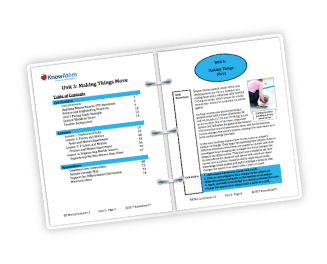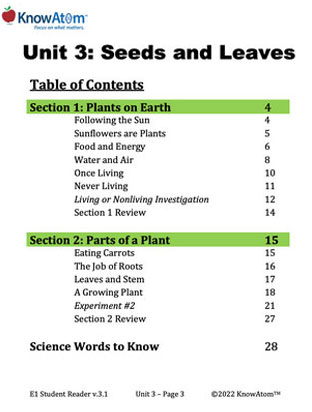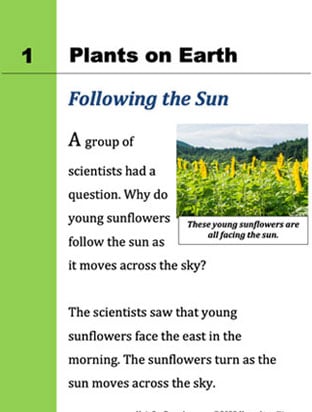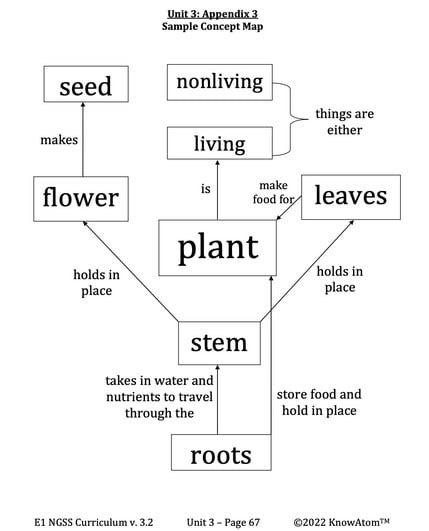In this lesson, students compare and contrast the characteristics that distinguish living things from nonliving and once living-things using picture cards.
In this unit, students discover living things, beginning with an investigation into the differences between living and nonliving things. Students then explore how water helps plants grow and develop the structures they need to survive.
Living things on Earth have certain things in common, and rely on both living and nonliving things in their environment to survive. This page provides a high-level extract of lesson one where students compare and contrast the characteristics that distinguish living things from nonliving and once-living things.
The science background gives teachers more in-depth information about the phenomena students are investigating in the unit.
Understanding why sunflowers track the sun as young plants and then stop as adults begins with understanding the importance of the sun in the survival of all plants. Plants use sunlight, along with water and air, to make their own food. This is important because all living things need food to survive, although different organisms have different ways of getting food.
An organism is a complete living thing that has the ability to carry out all functions for life. For example, plants make their own food, while animals have to eat other organisms for food.
Plants make their own food through a process called photosynthesis, which uses the sun’s energy to convert carbon dioxide and water into oxygen and a kind of sugar called glucose. During photosynthesis, chemical reactions happen that transform matter that is not food, including carbon dioxide and water, into matter that is food, specifically glucose. Glucose holds stored chemical energy, which plants use to grow and develop. Plants also use glucose as a building material for their structures. Whatever glucose they don’t use right away, they store. That stored glucose gets passed from plants to animals that eat plants. When we eat food, we get some of that stored glucose.
In this lesson, students compare and contrast the characteristics that distinguish living things from nonliving and once living-things using picture cards.

Prepared hands-on materials, full year grade-specific curriculum, and personalized live professional development designed to support mastery of current state science standards.
Flowers : the parts of a plant that make seeds
Leaves : the parts of a plant that collect sunlight and make food
Living : anything that breathes, needs food and water, grows, moves, and reproduces
Plant : a living thing that makes its own food from sunlight
Nonliving : anything that does not meet, and has never met, all of the requirements of life
Roots : the part of the plant that holds a plant in place and takes in nutrients and water from the soil
Seed : a young plant inside a protective coat; needs soil, water, and sunlight to grow
Stem : the part of a plant that holds the leaves and flowers in place; water and nutrients travel through the stem to the rest of the plant
Food and Energy
Food is important. It helps living things grow. As they grow, living things get bigger. They get more complex.
The scientists who studied sunflowers carried out experiments. They learned that young sunflowers grow more when they follow the sun. The sunlight allows the plants to make food.
Food gives living things energy. Living things need energy to move. Some living things move in ways we can’t see. It happens in their bodies.
One side of a sunflower stem grows more during the day. The other side grows more at night. This causes the sunflower’s face to move so it follows the sun. Other living things use energy to move from place to place.
Water and Air
Living things need water. Our bodies use water for many things.
All living things breathe. This means they exchange gasses with the environment. Animals breathe in oxygen. They breathe out carbon dioxide. Plants take in carbon dioxide. They release oxygen.
All living things reproduce. This means they produce young. Humans have babies. Birds lay eggs. Many plants produce seeds that will grow into new plants. Young plants and animals are similar to their parents. They aren’t exactly the same though.



For the hands-on activity of this lesson, students conduct an investigation to differentiate between living things, and nonliving or once-living things. They research and discuss the characteristics of living things before working collaboratively in small groups to sort things into living, nonliving, or once-living categories. Students discuss their reasoning behind each sorting decision and use their knowledge of living things to defend their claim.
KnowAtom incorporates formative and summative assessments designed to make students thinking visible for deeper student-centered learning.

Standards citation: NGSS Lead States. 2013. Next Generation Science Standards: For States, By States. Washington, DC: The National Academies Press. Neither WestEd nor the lead states and partners that developed the Next Generation Science Standards were involved in the production of this product, and do not endorse it.
